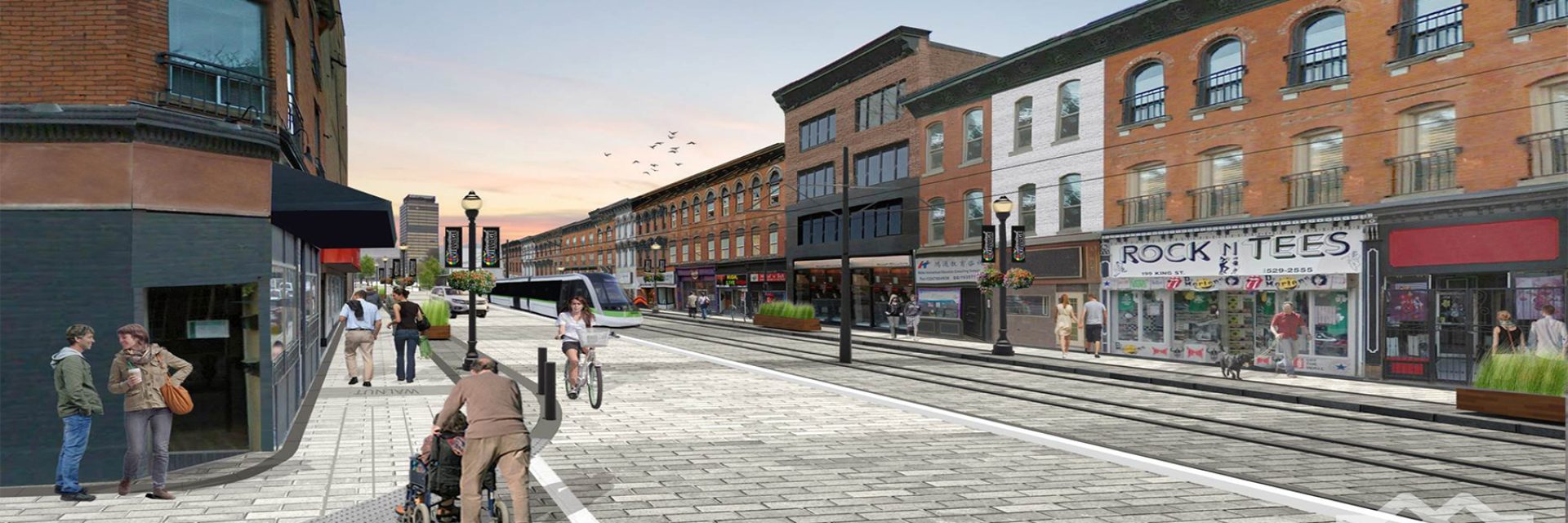All Aboard: Next Stop, LRT

Hamilton’s oft-delayed LRT system is back from the dead and past the point of no return, which has local transit fans celebrating. Here’s what you need to know.
First proposed in 2007, the 14-km Hamilton Light Rail Transit (LRT) line between McMaster University and Eastgate Square has endured a roller-coaster of political intrigue, including a dramatic cancellation in late 2019 when the province falsely claimed that project costs had spiralled out of control.
A transportation task force struck by the province in early 2020 to determine how to invest the LRT capital funding came back later the same year and recommended a shovel-ready “intra-city higher-order transit project that addresses the City of Hamilton’s transportation needs” – in other words, LRT.
In May 2021, a new funding partnership with the federal government secured $3.4 billion in capital and 30-year financing and lifecycle costs for a revived LRT. In September, Hamilton city council ratified a memorandum of understanding (MOU) with Metrolinx and the Ministry of Transportation.
Unlike the previous MOU from the cancelled project, the new agreement locks in the commitment by making Metrolinx the sole proponent in the transit procurement approval process. This is important: there are no more procedural “off-ramps” for skeptical councillors to play the endless delay game.
Metrolinx is responsible for capital, financing and lifecycle costs. The city will be responsible for operating and maintenance costs, but will also be able to collect operating revenues. In more good news for Hamilton, LRT ridership will count toward the city’s total transit ridership for the purpose of calculating our provincial gas tax transfer – more ridership growth means we get a bigger transfer.

For more information see
https://www.hamilton.ca/city-initiatives/priority-projects/light-rail-transit-lrt
https://www.metrolinx.com/en/greaterregion/projects/hamilton-lrt.aspx
Last fall, the province made Hamilton LRT an official priority project under the Building Transit Faster Act, which grants Metrolinx broader powers to expropriate properties along the proposed route and streamline regulatory barriers on an approved transit project.
Also last fall, Metrolinx began demolishing many of the buildings it had acquired along the line to build transit stations and other infrastructure. Utility relocation is slated to begin this spring, and Metrolinx is putting together a request for proposals (RFP) to construct the LRT system itself.
Depending on how long that RFP process takes, major construction could begin as early as the end of this year, with a total construction time ranging from three to five years, depending on whether construction is phased.
The timeline will depend on how long that RFP process takes, though the latest schedule from Metrolinx suggests major construction might not start until 2024. The total construction time will range from three to five years, depending on whether construction is phased.
One major outstanding question: who will operate the LRT system? Under the previous cancelled plan, Metrolinx would have contracted operation to the same consortium that was selected to design, build and maintain the system. But under the new MOU, Metrolinx has separated operation from its procurement model.
That means Hamilton’s own HSR could potentially end up operating the LRT, as well as the city’s fleet of buses. Since LRT is planned to be integrated with local bus service and the city has to cover operating costs, this could make a lot of sense.
When then-Infrastructure Minister Catherine McKenna, who shepherded the LRT funding agreement, made the announcement, she also stated that the project must include new affordable housing. The MOU recognizes this, committing the province to work with the city and community stakeholders to add affordable housing near LRT stations.
A key partner is the Hamilton Community Benefits Network (HCBN), a stakeholder collective dedicated to negotiating broad community benefits for the LRT, including training and employment opportunities for marginalized Hamilton residents and ensuring that LRT-related projects result in a net gain in affordable housing.
Meanwhile, last year the federal and provincial governments also announced $370 million in funding for Hamilton local transit, with $148.8 million in local matching funds. The money will cover seven transit projects over the next five years.
The biggest is a new 650,000-square-foot bus maintenance and storage facility. The feds are kicking in $100 million, the province is adding $83 million and Hamilton is on the hook for $81 million.
The money will also cover 92 replacement buses. The new buses will run on compressed natural gas (CNG) and will replace diesel buses that are being phased out due to age. In addition, there will be 85 new buses for expanded service.
Other initiatives include bus priority improvements along the north-south A-Line corridor, improved dispatching systems, replacement of the Birch Avenue rail bridge, 17.8 kilometres of new sidewalks, and upgraded multi-use infrastructure to connect to transit.






